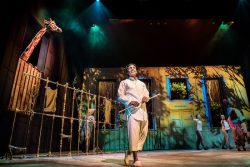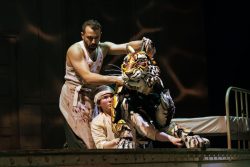 YANN Martel’s magic-realist philosophical story Life of Pi, winner of the Man Booker prize in 2002, is all about a boy from Pondicherry, named Piscine (which he has abbreviated to Pi), brought up in a zoo, with his family and other animals escaping violent uprisings on a Japanese ship that goes down in a storm en route to Canada, and finding himself on a life raft with a zebra, an orangutan, a hyena and a full-grown Bengal tiger called Richard Parker.
YANN Martel’s magic-realist philosophical story Life of Pi, winner of the Man Booker prize in 2002, is all about a boy from Pondicherry, named Piscine (which he has abbreviated to Pi), brought up in a zoo, with his family and other animals escaping violent uprisings on a Japanese ship that goes down in a storm en route to Canada, and finding himself on a life raft with a zebra, an orangutan, a hyena and a full-grown Bengal tiger called Richard Parker.
As you might imagine, this creates serious challenges for anyone determined to adapt it for the stage. But actor and playwright Lolita Chakrabarti was undaunted, and working with puppetry specialists Finn Caldwell and Nick Barnes, and a host of other vastly imaginative costume, lighting, sound and video designers, she created a mesmerising, thought-provoking and very exciting version of the story for theatre audiences. It is simply sensational, and it’s at Bath Theatre Royal until 25th May, heading for the last five weeks of a lengthy tour that started last August in Sheffield.
Many members of the cast are making their professional debuts in the show, which makes such extreme physical demands on its participants that a double cast is at the ready. On the night we saw it in Bath, Adwitha Arumugam took the title role, which she alternates with Divesh Subaskaran. Never offstage, she is the beating heart of Martel’s story, the child whose restless curiosity about the world and its workings takes the tale to its deeply felt conclusion. It is a wonderful performance.

 Perhaps the second star is the massive tiger, who is brought to life by three puppeteers named in the programme as Head, Heart and Hind. This is a universe away from old-style puppetry – I can remember Muffin the Mule and Bill and Ben the Flowerpot Men. Since Tom Morris fell in love with puppet potential in his National Theatre production of War Horse, and developed his passion with various productions at Bristol Old Vic, the world of puppetry has undergone a sea-change, and the practitioners touring in Life of Pi are creating real, violent, frightening, frightened, brave and cowardly, bragging and baying wildlife.
Perhaps the second star is the massive tiger, who is brought to life by three puppeteers named in the programme as Head, Heart and Hind. This is a universe away from old-style puppetry – I can remember Muffin the Mule and Bill and Ben the Flowerpot Men. Since Tom Morris fell in love with puppet potential in his National Theatre production of War Horse, and developed his passion with various productions at Bristol Old Vic, the world of puppetry has undergone a sea-change, and the practitioners touring in Life of Pi are creating real, violent, frightening, frightened, brave and cowardly, bragging and baying wildlife.
 Pi Patel mirrors the anthropomorphism of fables and vying religions in his two stories about his 227 days on a raft. The book is split into three sections. The stage version uses the finale of the book as a clever framing device to tell the story – we meet Pi in a Mexican hospital, where a Canadian civil servant and a Japanese investigator question the facts about the sinking of the ship and the survival of the boy.
Pi Patel mirrors the anthropomorphism of fables and vying religions in his two stories about his 227 days on a raft. The book is split into three sections. The stage version uses the finale of the book as a clever framing device to tell the story – we meet Pi in a Mexican hospital, where a Canadian civil servant and a Japanese investigator question the facts about the sinking of the ship and the survival of the boy.
The swirling stage takes the audience to the Indian streets and the zoo, the dock where the fated ship is loading cargo, to the ocean and an unidentified island. The storytelling is mesmerising, and not just because of the technology, which never threatens to overwhelm the narrative. I can well understand people wanting to see Life of Pi on stage, again and again.
GP-W
These images, by Johan Persson, were taken with another cast. Adwitha Arumugam, who played Pi, is pictured top right, phototraphed by Jake Stewart.